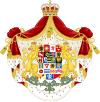
Back دوقية ساكسونيا كوبورغ وغوتا Arabic Casa de Saxonia-Coburgu y Gotha AST Saksen-Koburq-Qota Azerbaijani Саксен-Кобург-Гота Byelorussian Сакс-Кобург и Гота Bulgarian Sachsen-Coburg-Gotha Breton Saskokoburg i Gota (dinastija) BS Saxònia-Coburg-Gotha Catalan Sasko-kobursko-gothajské vévodství Czech Sachsen-Coburg og Gotha (land) Danish
This article needs additional citations for verification. (January 2017) |
Duchy of Saxe-Coburg and Gotha Herzogtum Sachsen-Coburg und Gotha (German) | |||||||||||||||
|---|---|---|---|---|---|---|---|---|---|---|---|---|---|---|---|
| 1826–1918 | |||||||||||||||
 The Duchy of Saxe-Coburg and Gotha (red) within the German Empire | |||||||||||||||
| Capital | Gotha (northern part) Coburg (southern part) | ||||||||||||||
| Common languages | German (Central Thuringian & East Franconian) | ||||||||||||||
| Government | Constitutional monarchy | ||||||||||||||
| Duke | |||||||||||||||
• 1826–1844 | Ernest I | ||||||||||||||
• 1844–1893 | Ernest II | ||||||||||||||
• 1893–1900 | Alfred | ||||||||||||||
• 1900–1918 | Charles Edward | ||||||||||||||
| History | |||||||||||||||
• Established | 1826 | ||||||||||||||
| 18 November 1918 | |||||||||||||||
| Currency |
| ||||||||||||||
| |||||||||||||||
Saxe-Coburg and Gotha (German: Sachsen-Coburg und Gotha), or Saxe-Coburg-Gotha (German: Sachsen-Coburg-Gotha [ˈzaksn̩ ˈkoːbʊʁk ˈɡoːtaː]), was an Ernestine duchy in Thuringia ruled by a branch of the House of Wettin, consisting of territories in the present-day states of Thuringia and Bavaria in Germany.[1] It lasted from 1826 to 1918. In November 1918, Charles Edward, Duke of Saxe-Coburg and Gotha, was forced to abdicate. In 1920, the northern part of the duchy (since 1918 the Free State of Gotha; culturally and linguistically Thuringian) was merged with six other Thuringian free states to form the Free State of Thuringia: Saxe-Weimar-Eisenach (until 1918 a grand duchy), Saxe-Altenburg and Saxe-Meiningen (until 1918 duchies), Schwarzburg-Rudolstadt and Schwarzburg-Sondershausen (until 1918 principalities), as well as the People's State of Reuss (until 1918 the principalities of Reuss-Gera and Reuss-Greiz). The southern part of the duchy (since 1918 the Free State of Coburg; culturally and linguistically Franconian), as southernmost of the Thuringian states, was the only one which, after a referendum, became part of the Free State of Bavaria.[2]
The name Saxe-Coburg-Gotha also refers to the family of the ruling House of Saxe-Coburg and Gotha, which played many varied roles in the dynastic and political history of Europe in the 19th and 20th centuries. In the early part of the 20th century, before the First World War, it was the family of the sovereigns of the United Kingdom, Belgium, Portugal, Bulgaria, and Saxe-Coburg-Gotha. In 1910, the Portuguese king was deposed, and the same thing occurred in Saxe-Coburg-Gotha in 1918 and in Bulgaria in 1946. As of 2024[update], a branch of the family still reigns in Belgium. The former Tsar of Bulgaria, Simeon II (reigned 1943–46), kept his surname while serving as the Prime Minister of Bulgaria from 2001 to 2005.
- ^ See also Davies, Norman (2012). Vanished Kingdoms: The Rise and Fall of States and Nations. Penguin Books. pp. 539–573. ISBN 978-0-1431-2295-1.
- ^ Winterbottom, Derek (31 July 2016). The Grand Old Duke of York: A Life of Prince Frederick, Duke of York and Albany 1763 1827. Pen and Sword. p. 181. ISBN 978-1-4738-4580-0.

